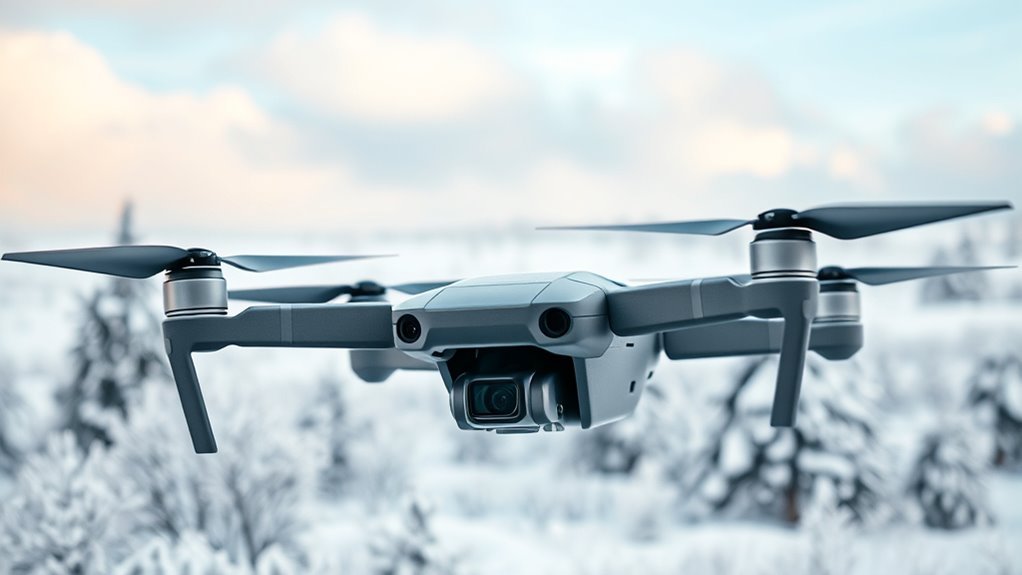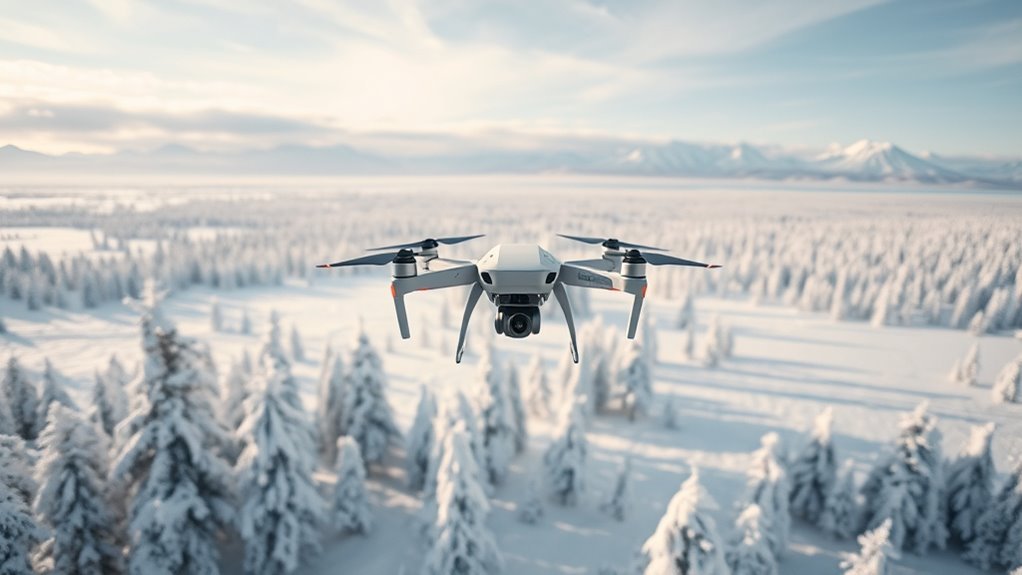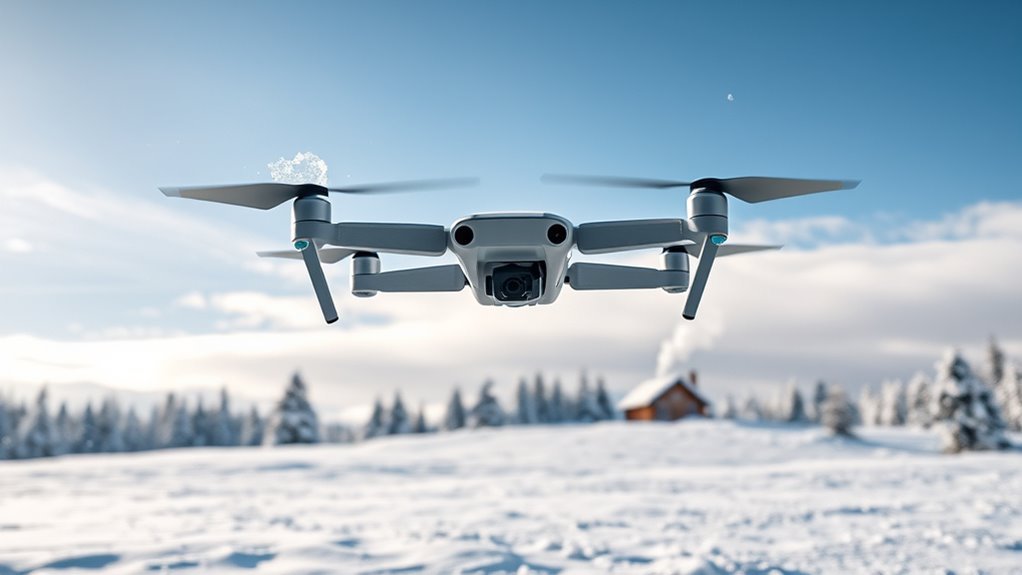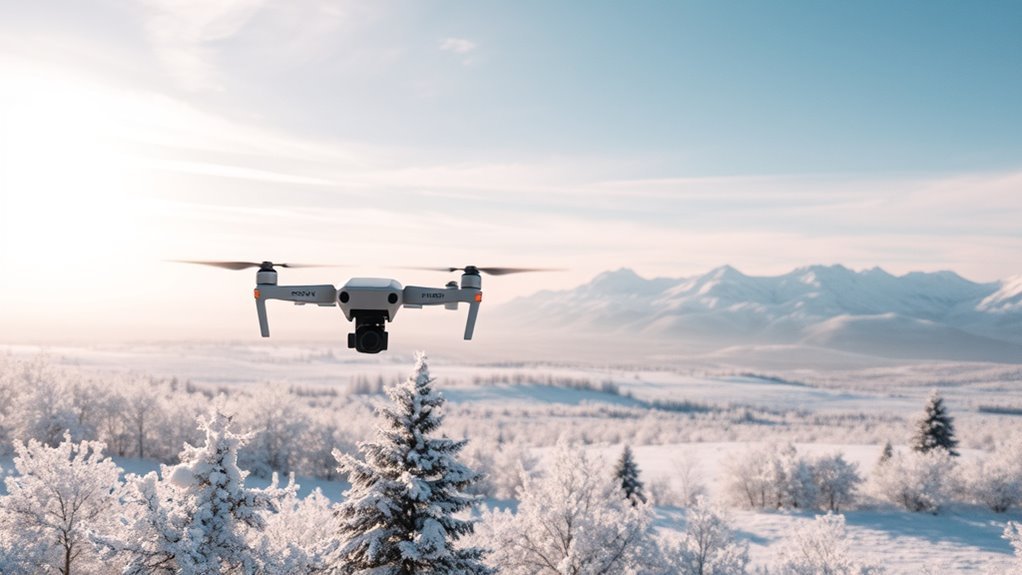To fly drones in snowy conditions, check your drone’s weather resistance ratings and make certain it’s made from durable materials. Prepare your batteries by insulating them and warming them before use. Use propeller guards to prevent damage and enhance stability. Monitor performance and landing zones carefully throughout your flight. Keep your camera lens clear of snow with a microfiber cloth. Be aware of potential signal interference from snowflakes and plan your flight path strategically. Discover further insights to optimize your snowy drone experience.
Check Your Drone’s Weather Resistance

Before venturing out into snowy conditions, it’s crucial to assess your drone’s weather resistance. Start by checking its weather ratings, which indicate how well it can withstand various environmental elements. Key factors include drone durability against moisture, temperature fluctuations, and wind resistance. Look for drones with an IP (Ingress Protection) rating; higher numbers suggest better protection from snow and water. Additionally, consider the material construction—carbon fiber or reinforced plastics often offer superior resilience compared to standard materials. Verify any exposed components are sealed or protected to prevent moisture intrusion. By understanding your drone’s limitations, you can make informed decisions, maximizing your freedom to explore and capture stunning winter landscapes without risking damage to your equipment. Furthermore, it’s essential to consider the weight capacity constraints of your drone, as heavy loads can strain battery life and affect flight stability in challenging weather conditions. Drones like the Intel Shooting Star 2, designed for advanced processing and real-time data handling, may offer benefits in dynamic conditions due to their robust safety features.
Prepare Your Batteries for Cold Weather

Snowy conditions not only test your drone’s structural integrity but also impact battery performance. Cold temperatures can greatly reduce battery capacity, leading to shorter flight times and potential malfunctions. To maintain ideal performance, you should invest in battery insulation to minimize heat loss. Consider using insulated pouches or thermal wraps specifically designed for drone batteries. Additionally, take cold weather precautions by storing your batteries indoors before use, allowing them to reach a more favorable temperature. Before flying, warm them up in your hands or a pocket for a short time. Monitor battery levels closely during flights, as cold weather can cause sudden drops in charge. By preparing your batteries properly, you enhance your drone’s reliability in snowy conditions.
Use Propeller Guards for Added Safety

While flying in snowy conditions, utilizing propeller guards can greatly enhance safety and protect your drone from potential damage. The harsh environment can introduce unexpected obstacles, such as ice and snow drifts, which could lead to propeller strikes. By installing propeller guards, you guarantee greater propeller safety, minimizing the risk of costly repairs or downtimes. These guards act as a buffer, preventing snow accumulation and reducing the likelihood of collisions with unseen objects. Additionally, they also improve the stability of your drone during flight, allowing you to maneuver with confidence. Investing in propeller guards not only fortifies drone protection but also gives you peace of mind, enabling you to explore the snowy landscape without unnecessary fear of equipment failure.
Monitor the Drone’s Performance
When flying drones in snowy conditions, it’s vital to monitor performance metrics carefully. You’ll need to assess battery efficiency, check propeller functionality, and evaluate how temperature impacts overall operation. These factors are essential for ensuring reliable flight and preventing potential malfunctions.
Battery Efficiency Monitoring
Monitoring battery efficiency in drones operating in snowy conditions is essential, as cold temperatures can considerably impact performance. Low battery temperatures can lead to reduced voltage and overall power output, affecting your flight time and stability. To guarantee peak performance, regularly check the battery temperature before and during your flight. Implement voltage management strategies by using a battery management system that monitors voltage levels in real-time. This allows you to anticipate potential issues and adjust your flight plans accordingly. Additionally, consider preheating your batteries to improve efficiency before launch. By closely monitoring these parameters, you’ll maintain your drone’s performance and enjoy the freedom of flying in snowy environments without compromising safety.
Propeller Performance Check
Propeller performance is critical for ensuring stable flight in snowy conditions. You need to assess both the propeller material and propeller pitch carefully. In cold weather, certain materials can become brittle, affecting their integrity and response. Make sure your propellers are made from durable composites that resist snow accumulation and minimize flex.
Next, evaluate the propeller pitch for ideal performance. A higher pitch can enhance speed but may reduce lift in heavy snow. Conversely, a lower pitch improves lift but may limit your drone’s speed. Adjusting these parameters can help you achieve the right balance for stable flight. Regular inspections and adjustments are essential to maintain the freedom of flight you seek while traversing through challenging snowy environments.
Temperature Impact Assessment
Cold temperatures can greatly affect your drone’s overall performance, making temperature impact assessment an essential part of your flight preparation in snowy conditions. In cold weather, battery efficiency declines, reducing flight time and power output. Monitor your drone’s battery level closely, as temperature effects can lead to abrupt performance drops. Additionally, check the motors and electronic components for any signs of sluggishness or lag, as these can be exacerbated by low temperatures. You should also consider the effects of cold on your drone’s sensors, which may respond slower or provide inaccurate readings. Conduct thorough pre-flight checks and adjust your flight plans accordingly, ensuring you’re ready to navigate the unique challenges presented by snowy conditions.
Keep the Camera Lens Clear of Snow
In snowy conditions, it’s crucial to maintain a clear camera lens to guarantee the best image quality. You can use anti-fog solutions to prevent moisture buildup and should regularly wipe the lens to remove any accumulated snow or ice. By keeping the lens clear, you’ll enhance your aerial footage’s clarity and detail.
Use Anti-Fog Solutions
To guarantee peak performance when flying drones in snowy conditions, utilizing anti-fog solutions is essential for keeping the camera lens clear of snow and moisture. Fog can severely impair visibility, compromising your ability to capture stunning aerial footage. Implementing effective fog prevention methods, such as applying anti-fog sprays or wipes, can greatly enhance lens clarity. These lens protection solutions create a barrier that minimizes condensation build-up and repels snowflakes, ensuring your camera remains functional in challenging weather. Additionally, consider adjusting your drone’s operating temperature to reduce the chance of fog formation. By taking these proactive steps, you can enjoy the freedom of flying in snowy environments while maintaining ideal camera performance.
Regularly Wipe Lens
While flying your drone in snowy conditions, it’s essential to regularly wipe the camera lens to prevent snow accumulation and maintain clear visibility. Accumulated snow can obscure your view, compromising both your ability to navigate and the quality of your footage. For effective lens maintenance, carry a microfiber cloth specifically designed for optics. When you notice snow forming on the lens, pause briefly to perform snow removal, guaranteeing you don’t miss capturing important moments. Avoid using your fingers, as they may leave smudges; instead, use the cloth to gently wipe the lens in a circular motion. Maintaining a clear lens enhances your flying experience and guarantees you achieve the freedom to explore breathtaking winter landscapes without hindrance.
Plan Your Flight Path Carefully
Although flying drones in snowy conditions can be challenging, careful planning of your flight path is essential to secure safety and efficiency. Start with flight route optimization; analyze your intended area for obstacles like trees or power lines hidden under snow. Use snow navigation strategies to anticipate how snow can impact visibility and drone performance. Mapping out a route that minimizes risk allows for quick adjustments if conditions change and also takes into account signal strength which can be affected by environmental factors. Consider wind patterns and temperature fluctuations, as these can affect battery life and control. Also, identify safe landing zones in case of emergencies. By proactively planning your flight path, you can guarantee a more enjoyable and successful flight experience, embracing the freedom that drone flying offers even in winter environments. Additionally, be aware that battery efficiency can diminish in extreme cold temperatures, which may affect your drone’s range and performance.
Be Aware of Signal Interference
Signal interference is a critical factor to take into account when flying drones in snowy conditions. The combination of snow and cold can create unique challenges that lead to signal disruption. Snowflakes and ice crystals can reflect and refract radio waves, causing unpredictable interference sources that might affect your drone’s communication with the controller. Additionally, other electronic devices in the area may contribute to these disruptions, further complicating your operation. To mitigate potential issues, verify your drone’s firmware is up to date, and consider using a frequency with less congestion. Always monitor the signal strength during your flight, and be prepared for sudden drops in connectivity. Understanding these factors can help you maintain control and achieve the freedom you seek in snowy environments.
Frequently Asked Questions
Can I Fly My Drone in Heavy Snowfall?
You can fly your drone in heavy snowfall, but consider how snow conditions affect drone performance. Moisture can impact electronics, and reduced visibility may hinder navigation. Always weigh risks against your desire for freedom in flying.
What Are the Best Drones for Winter Flying?
Choosing the right winter drone’s like selecting a reliable winter coat. Look for drones with robust battery performance and weather-resistant features to guarantee peak operation in cold conditions, enabling you to explore without limitations.
Is It Safe to Fly Drones in Low Visibility?
Flying drones in low visibility presents significant visibility challenges. You should prioritize safety precautions, like maintaining line of sight and using advanced sensors, to guarantee safe operation. Always assess environmental conditions before taking flight.
How Do I Recover a Drone Lost in Snow?
About 15% of drone pilots lose their drones annually. For snow recovery, utilize drone tracking apps to pinpoint your device’s location. Once found, carefully excavate it from the snow to avoid damage and guarantee proper functioning.
Do I Need Special Insurance for Winter Drone Flights?
You don’t necessarily need special winter insurance for drone flights, but ensuring your drone coverage includes winter conditions is wise. This protects against potential damages, enhancing your freedom to explore winter landscapes without worry.

